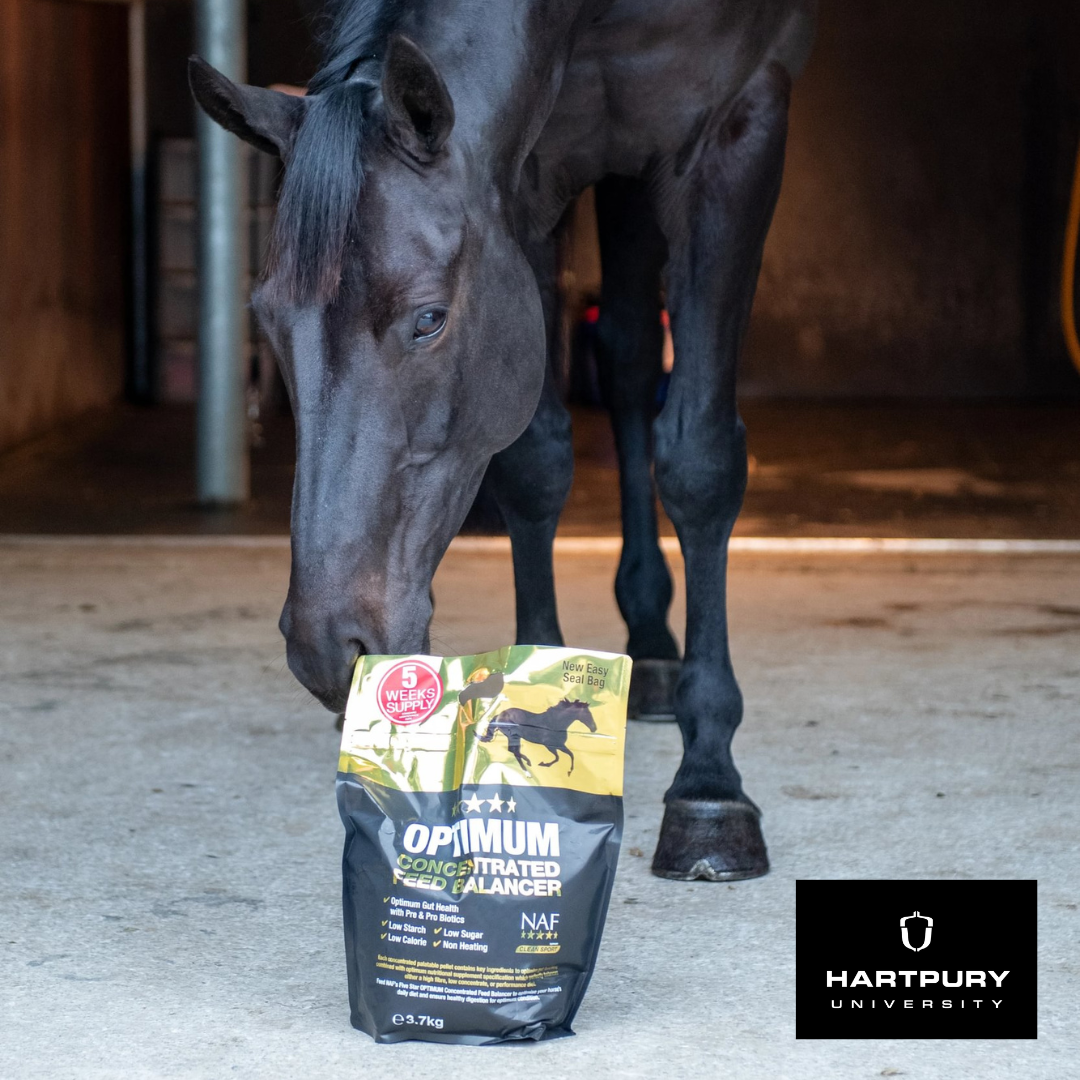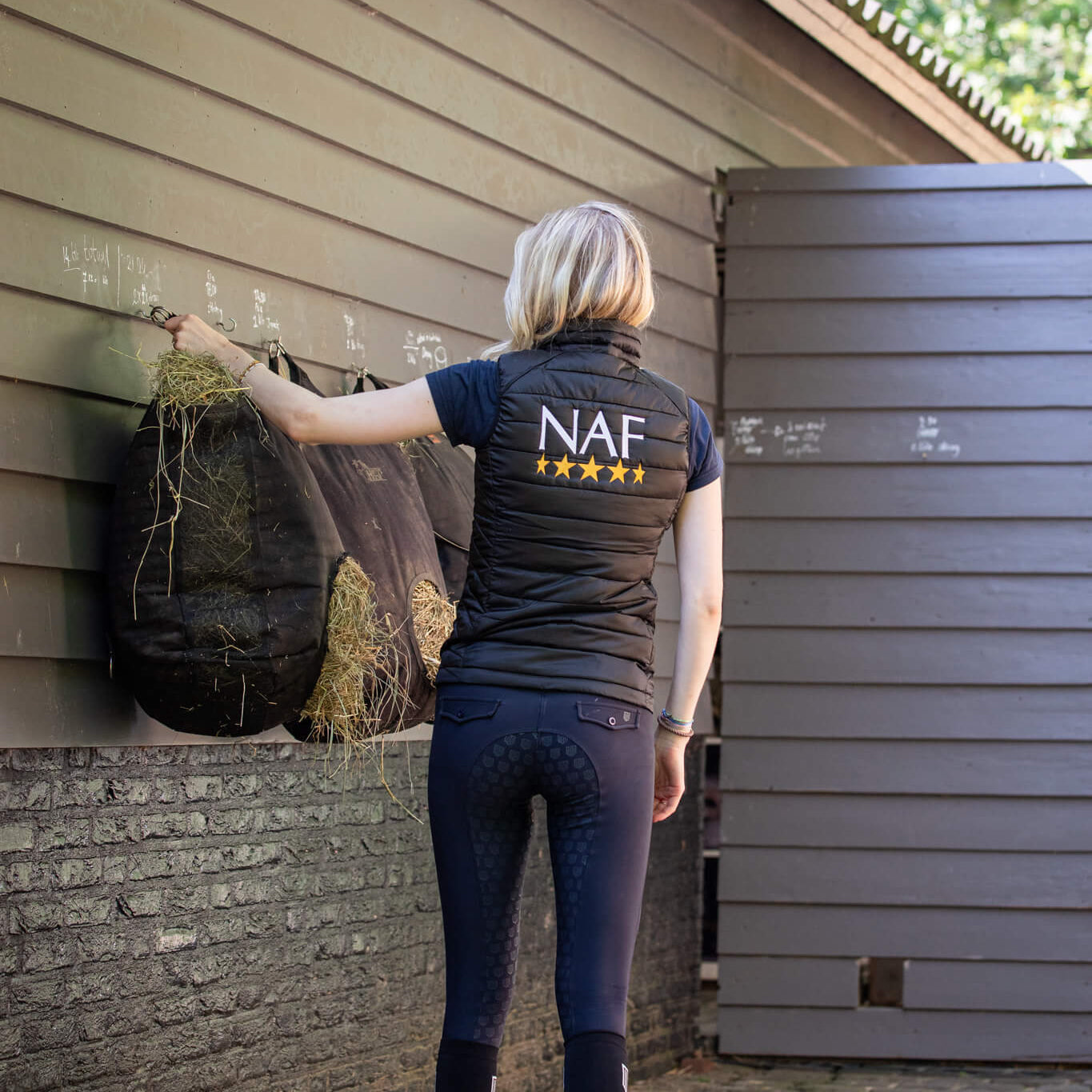Winter is fast approaching, and horses’ coats are beginning to thicken in preparation for the colder months. Across the fields, the vibrant shades of green are giving way to rich autumnal tones. As temperatures drop and winds strengthen, some horses are brought in overnight while others remain out. Independently of individual routines and management choices, autumn comes as a reminder of how these aspects can influence their nutritional needs.
With shorter days and cooler weather, grass growth slows and its nutrient quality is impacted. As the pastures lose their richness, hay and haylage start to gradually replace the role of fresh summer forages. This more than natural shift in diet makes autumn the ideal time for us to stop and take a closer look at what exactly is being fed to our horses, and contemplate if they are actually getting everything they need to stay healthy and happy through the changing season.
No forage, whether hay or haylage, will ever fully supply all the nutrients a horse needs. This is true throughout the year, but as pastures decline in quality, those nutritional gaps can become even more noticeable. That is exactly when the practicality of a ration balancer comes to light, they are a simple, but very effective tool to keep your horse’s nutrition balanced and complete.
What is a Balancer?
A balancer is a nutrient-dense concentrated feed, designed to complement a dietary plan by addressing possible nutrient gaps or deficiencies. Its effectiveness surrounds the available essential vitamins, minerals and amino acids, provided in the shape of a low volume and low calorie pallet or powder. A well formulated balancer also has the benefit of supporting efficient nutrient utilization, helping the body to make better use of what the diet already provides. When nutrients are used efficiently, it is reflected in overall wellbeing, from maintained muscle tone and sound hooves to a healthy, well-conditioned coat.
The nutrients supplied by a balancer are extremely concentrated, which in practice means that its feeding can be done in considerably small portions. Recommended feeding rates will vary according to their individual formulation and nutrient density. Typically balancers range around 100-150g per day, such as the super-concentrated NAF Optimum Feed Balancer, up to around 500g per day per horse.
Balancers differ in format and concentration, which is why some are supplied in larger feed bags while others come in smaller pots. These aspects simply reflect how much is needed to deliver a full daily ration of nutrients. All variances seen across products should always be acknowledged when planning feeding regimen. Thus, it is essential to always strictly follow the specific feeding guidelines provided by each product.
Why is Autumn a Good Time to Revisit and Rebalance?
Autumn traditionally marks a time of transition and a practical turning point for many horse owners. As the days cool, it offers owners and carers both a challenge and an opportunity to reassess feeding routines. It’s the ideal moment to make sure that our horses’ diet will evolve with the season, continuing to meet their changing nutritional needs.
Regardless of the time of year, forages must always form the foundation of every horse’s diet. They are the primary source of fibre, which is an essential macronutrient for maintaining a healthy digestive system, supporting the hindgut’s microbial balance and satisfying the horse’s natural need to chew and forage throughout the day.
With the change of season and the inevitable reliance on preserved forage, it’s important to reinforce that even in the highest quality, they cannot provide every nutrient required for optimal health. Besides the nutrient loss that comes with harvesting and storage, the mineral content present will also be impacted by the quality of the soil in which it was grown. The UK has multiple types of soil that vary widely in their nutrient profile, still deficiencies in trace elements like copper, zinc and selenium are very commonly seen in many of them. Forage grown on such regions may already be low in these minerals even before any further reductions take place during conservation. Particularly, Vitamin E, shows significant losses after harvest. Because of its high instability, in the space of two weeks, hay can lose more than half its content, with the risk of reaching up to 80 percent if stored for too long.
It is also worth mentioning that when a horse appears to lack energy, it’s easy to assume they need more feed. In reality, reduced vitality can also come from micronutrient shortfalls rather than a lack of calories. Before reaching for hard feeds, take a moment to investigate whether the diet provides a complete and balanced mineral profile, and a balancer is a great way of doing that.
When is a Balancer Useful?
There are many possible scenarios in a horse's life where the use of a balancer would be recommended:
- Good doers, or horses that tend to gain weight a bit too easily, can benefit greatly from a balancer. It provides a way of having their diet nutritionally complete without having to rely on sources that come with many unnecessary extra calories and increase their risk of further weight gain.
- For performance horses, especially now that the competition season is slowing down, the use of a balancer would allow a reduced consumption of higher-energy feeds, alongside the risk of starch overload. The result would be the maintenance of an optimal physical condition and digestive comfort.
- Developing youngstock needs balanced levels of protein, minerals and vitamins, to have its tissue development supported and remaining healthy. While forages can provide the protein required for growth, when it comes to the micronutrient levels, they can vary and are more likely to fall short. With less nutrients available from pasture, the use of a balancer can help to ensure complete nourishment, without increasing the risk of overfeeding.
- Senior horses have to deal with all the aspects that come alongside ageing, some of them becoming noticeable through their digestive capability, mobility and overall condition. Providing them with appropriate antioxidants and digestible protein, all present at the formulation of senior balancers, can support their nutrient uptake and overall wellbeing, while keeping them comfortable, active and well-nourished throughout the colder months.
Balancers vs. Traditional Feeds and Supplements
It’s a common assumption that horses need more feed as the weather cools, but in most cases, they don’t require extra calories, just a better nutrient balance. Even as temperatures drop, most horses can maintain body condition through forage alone. However, once again, forage falls short in providing the full spectrum of essential vitamins, minerals and amino acids.
Traditional mixes, cubes and even straights provide more than just nutrients, and actually deliver a significant amount of extra energy, usually in the form of starch. While this can benefit horses in regular, intense work, it may also lead to unwanted weight gain and sometimes digestive stress when activity levels decrease. In addition, many conventional concentrate feeds do not always offer the ideal ratios of all the essential micronutrients needed for maintaining their health.
A well-formulated balancer offers a targeted alternative that is highly palatable, easy to feed and provided in a small volume with insignificant starch. It delivers essential micronutrients to support a horse’s diet, helping to maintain a balanced and consistent intake without the risk of overloading the digestive system.
In theory, the difference between a balancer and a supplement comes from feeding rate rather than its nutritional purpose. While a balancer falls under the category of a concentrated feed, providing a more general range of essential nutrients, a supplement is added in even smaller amounts, with the objective of targeting a specific need. In practice, some supplements, such as NAF In The Pink, offer a balanced micronutrient profile similar to that of a traditional balancer
Choosing the Right Balancer
There are many types of balancers available in the market, so before choosing one, think about your horse’s current condition, their appetite levels and the challenges that will come with the season ahead. Consider how their workload, age and the type of forage they’re eating might influence what their needs are. Always follow the feeding guidelines carefully to ensure your horse receives the correct amount of nutrients, and if there are any doubts or uncertainty, be sure to seek advice from a professional.
Within all the many balancer options available in the market, you must be able to determine which one is the best fit for your horse. When making your choice, think about what condition is your horse currently in, what is his level of appetite and what are the challenges that will come with the season ahead. Their workload, age and current nutritious plan should all be taken into consideration before determining what their needs are.
NAF has a range of balancers, each designed to meet the demands of different horses, all of which you can find on our website, alongside their in-depth composition and specific feeding recommendations.
Low-calorie balancers – Ideal for those prone to weight gain or excess condition. They are commonly used during "rest periods”, where grazing is limited and the use of traditional compound feeds would likely oversupply energy. This type of balancer provides a complete nourishment without adding extra calories. Our “Slim Pellets” would fall within this category, as its use is advisable for healthy weight management while still keeping a full balanced diet.
Daily or Performance balancers – Ideal for horses in regular or demanding work, as they support muscle development, performance, and recovery while helping to maintain digestive health. Their use is preferable especially when the addition of bulk feeds would result in a higher risk of a digestive upset or excess energy. It’s challenges like these that inspired the creation of our Optimum Feed Balancer, a concentrated, versatile formula designed to support horses across a wide range of workloads and nutritional needs.
Senior balancers – This type of balancer, just like the Pink Senior formulation, is best used for older horses that may be facing reduced digestive efficiency, muscle loss, or dental limitations. It supports the maintenance of condition, vitality and metabolic health, helping to reduce the risk of nutritional imbalances associated with ageing.
Stud and youngstock balancers – Used for growing or breeding horses needing extra micronutrients, without overfeeding the calories aspect. These compositions are generally designed to provide the right nutrition to prevent deficiencies that can lead to developmental orthopedic diseases and adjust mineral levels to support correct bone mineralisation.
- VitaMare is expertly formulated to meet the specific demands of the broodmare throughout gestation, providing vital vitamins, minerals and trace elements to promote wellbeing and foetal development.
- Mare, Foal & Youngstock supplement delivers a broad-spectrum blend of essential nutrients that aim to promote bone development (calcium and phosphorus), enzyme function (zinc), connective tissue (cooper), and muscle health (vitamin E).
Horses that rely heavily on haylage can benefit from a more specialised product, usually designed to maintain gut stability and nutrient absorption; something similar to our Haylage Balancer.
Before actually adopting the use of a balancer, be sure to carefully read through the manufacturer's guidelines and follow them very closely. If any doubts or uncertainties end up coming to surface, do not hesitate to contact a professional or take advantage of the nutritional helpline for advice and clarification.
Final Thoughts
Autumn is all about preparation, especially at the feed room. With all the changes that occur throughout this season, making sure early in that our horse's diet stays balanced is one of the simplest and most valuable things we can do for their wellbeing.
A ration balancer may be just a small addition to your horse’s routine, but it can make a big difference if used correctly. When the nutritional gaps that may appear with declining pasture quality are filled, muscles stay strong, hooves remain healthy, and coats shine even through the colder season.
So, as you adjust rugs, check hay supplies and plan for the months ahead, take a moment to slow down and think about what is actually in your horse’s feed bowl and why it is there. If appropriate, with the right balancer, you can be confident that they’ll stay healthy and ready to face whatever the season brings.
Written by: Catarina Marinho,Hartpury University Undergraduate Student, BA (Hons) Equine Business Management
Selected References
- Harris, P. and Dunnett, C. (2016). Nutritional tips for veterinarians. Equine Veterinary Education, 30(9), pp.486–496.
- Moore-Colyer, M., Westacott, A., Rousson, L., Harris, P. and Daniels, S. (2023). Where Are We Now? Feeds, Feeding Systems and Current Knowledge of UK Horse Owners When Feeding Haylage to Their Horses. Animals, [online] 13(8), p.1280.
- Shepherd, M.L. (2022). How to Feed the Overweight Performance Horse. AAEP PROCEEDINGS, 66.
- Stoneham, S.J., Tyler, N., Holmes, M.A. and Archer, D.C. (2025). Does dietary supplementation of pregnant mares with a commercial stud feed balancer improve the transfer of passive immunity in their foals? A controlled field trial. Journal of Equine Veterinary Science, [online] 145, p.105346.
- Fordyce, F. (2013). Selenium Deficiency and Toxicity in the Environment. In: O. Selinus, ed., Essentials of Medical Geology. [online] Springer, pp.375–416.


